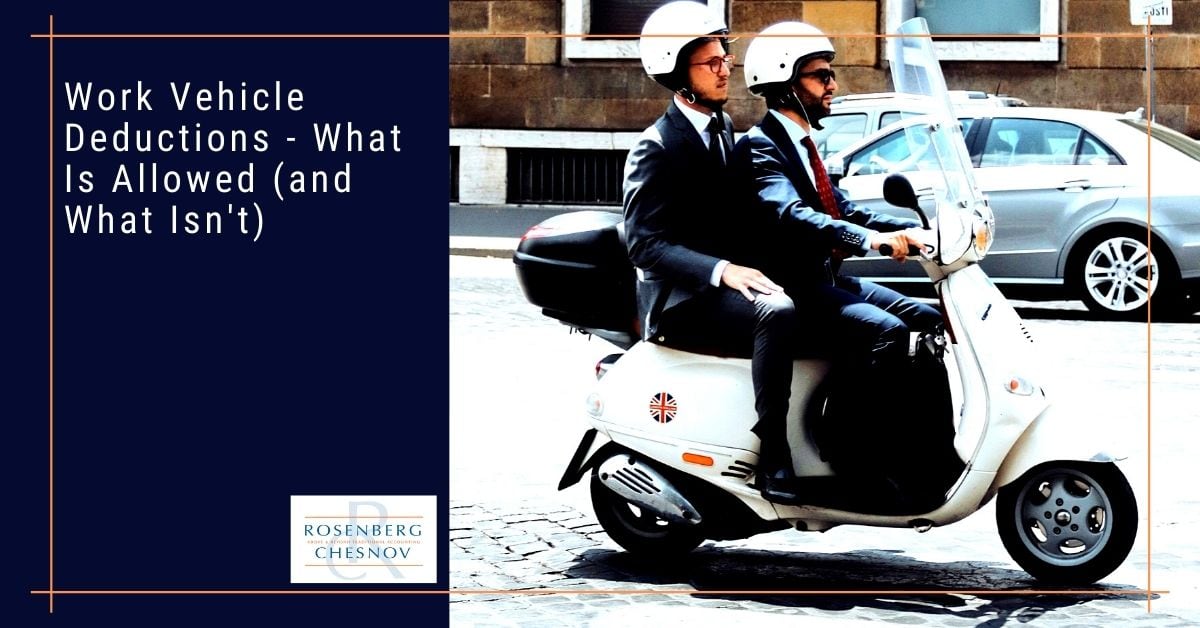What is a business vehicle?
A business vehicle is any vehicle (car, SUV, pickup, jalopy) used for business purposes such as driving to and from meetings or carrying out business activities.
Business vehicles do NOT include vehicles used as equipment such as a dump truck or any cars “used for hire” like taxi cabs or transport vans. These fall under a different category.
Generally, the IRS likes business vehicles not to be luxury cars. To encourage more economical transportation, the tax code limits deductibility amounts. The idea is that more expensive “luxury” cars do not get as much of a tax break. Therefore the maximum first-year depreciation write-off is $10,100 (plus an additional $8,000 in bonus depreciation in 2020).
This can get a little complex, so know that if you buy and depreciate an expensive vehicle, you may not be able to depreciate it as quickly as you expect.
Who should own the vehicle?
We get this question a lot from self-employed and small business owners. Should the person own the vehicle, or should the corporation?
The truth is that ownership is not a critical issue when it comes to cars: usage is much more important.
If a vehicle is owned by a business and then used personally, that personal use counts as income to the individual.
Likewise, if the car is owned by an individual and operated for business, the individual can claim the business use as a business expense. You can either claim this directly as an expense if you are self-employed or submit a reimbursement request to the corporation if you are an employee or part of a corporation. (Even if you OWN the corporation since it is a separate entity, you may end up submitting expense reimbursement requests).
A case in which it may be better for the company to own the vehicle is when it is used exclusively for business, and multiple people will use it. Think of a maid service with a fleet of cars that are only used for business. In this case, it will probably make sense for the business to own the cars and let various employees use them rather than have each employee own their own car.
The question of ownership often comes down to ease of record keeping. It is generally simpler for a business to allow the employee (partner or member) to use their personal vehicle and submit an expense reimbursement request. This eliminates a significant amount of record-keeping for the employer and makes the record keeping cleaner/easier to understand.
What is “business use” of a vehicle?
Business use includes any driving you do for business purposes. This can include (but is not limited to):
- Visiting a customer or meeting a client.
- Visiting offices or locations.
- Going to the bank, office supply, or other vendor location.
- Going to meetings with vendors, lawyers, or other individuals on business matters.
- Going from the office to a job site.
Driving that the tax code excludes from business use includes:
- Commuting. Driving from your home to your workplace and back is not a business use and is never deductible.
- There are other nuances as well; if, for example, you stop at the store on the way home from a business trip, the miles from the store to home are not considered business use.
Standard mileage rate versus actual expense
When you claim a deduction for vehicle expenses, you can choose to claim the standard mileage rate, a per-mile rate set by the IRS, or actual vehicle costs. Which one to claim depends entirely on your situation and the vehicle you use. You should choose the one that gives you the highest deduction.
- The cheaper your vehicle is to operate, the more likely the standard mileage rate will yield a larger deduction.
- The more expensive your vehicle is to operate, the more likely the actual cost method will be your best option.
Another factor to consider is the ease of record-keeping: the standard mileage rate is often the easiest to track.
Below I explain both.
How the standard mileage rate works
The IRS sets a “standard mileage rate” for employees and self-employed individuals to calculate vehicle expenses. It changes every year and is the IRS’s estimate of the average cost of operating a vehicle.
In 2020 the standard mileage rate was 57.5 cents per mile. In 2021 it is 56 cents per mile. You can check the current rate here.
When you use your vehicle for business, track your miles using a log. We have a mileage tracker you can use, download it here.
Track where you went, the reason for the trip, and the reading before and after the trip. You add up all of these miles and multiply them by the standard mileage rate to calculate the deduction.
If you use the standard rate, you can also deduct:
- Interest on an auto loan,
- Registration and property tax fees,
- And business-related parking and tolls.
The alternative: deducting actual vehicle expenses
The alternative to the mileage deduction is to deduct actual vehicle-related expenses such as:
- Gas and oil.
- Tires.
- Maintenance and repairs.
- Licenses.
- Insurance.
- Rental or lease payments.
- Depreciation.
- Garage rent.
- Business-related parking and tolls (also deductible if you use the standard rate).
- Vehicle loan interest (also deductible if you use the standard rate).
- Registration fees and taxes (also deductible if you use the standard rate).
You can deduct the actual expenses at the same rate as you use the vehicle for business. If you use the car 50% of the time for business and 50% of the time for personal uses, you deduct 50% of the expenses.
So, to get the best deduction, you should track the mileage and vehicle-related expenses. At the end of the year, add everything up, calculate both the standard and actual vehicle expenses, and take the higher deduction.
Should you buy or lease?
There are some caveats to leased vehicles that you should understand when making this decision.
You can use either the standard mileage or actual expense method for a leased vehicle. However: if you use the standard mileage rate, you cannot switch to the actual expense method in a later year.
- If you use the standard mileage rate, then the lease expense is assumed, so you do not claim an additional deduction for the lease payment.
- If you use the actual expenses method, then you use the lease payment instead of depreciation.
Calculating the lease payment can be easier than estimating depreciation but depreciation may give you a bigger benefit. So the answer to lease versus buy is that it depends. The best thing to do is estimate usage, run the numbers and calculate which strategy gives you the greatest advantage.
Would you like some help?
If you are a client and would like to book a consultation, call us at +1 (212) 382-3939 or contact us here to set up a time.
If you aren’t a client, why not? We can take care of your accounting, bookkeeping, tax, and CFO needs so that you don’t have to worry about any of them. Interested? Contact us here to set up a no-obligation consultation.
Stay informed
Interested in receiving updates in your mailbox? Check out our newsletter, full of information you can use. It comes out every two weeks and you can register for it below.





